Biology deletion - Study guides, Class notes & Summaries
Looking for the best study guides, study notes and summaries about Biology deletion? On this page you'll find 357 study documents about Biology deletion.
Page 4 out of 357 results
Sort by
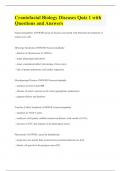
-
Craniofacial Biology Diseases Quiz 1 with Questions and Answers
- Exam (elaborations) • 5 pages • 2024
-
Available in package deal
-
- $7.99
- + learn more
Craniofacial Biology Diseases Quiz 1 with Questions and Answers Neurocristopathies ANSWER group of diseases associated with abnormal development of neural crest cells DiGeorge Syndrome ANSWER Neurocristophathy - deletion of chromosome 22 (TBX1) - major pharyngeal glad defect - minor craniofacial defect (shortening of lower jaw) - lack of proper pulmonary and cardiac separation Hirschsprungs Disease ANSWER Neurocristophathy - mutation in Sox10 and ERB - absense of enteric n...
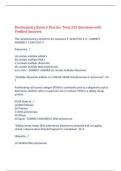
-
Biochemistry Exam 3 Practice Tests 225 Questions with Verified Answers,100% CORRECT
- Exam (elaborations) • 59 pages • 2024
-
- $13.49
- + learn more
Biochemistry Exam 3 Practice Tests 225 Questions with Verified Answers The complementary strand for the sequence 5' GCACTTCG 3' is - CORRECT ANSWER 5' CGAAGTGC 3' Polysomes...? (a) contain multiple mRNA's (b) contain multiple DNA's (c) contain multiple ribosomes (d) contain multiple RNA polymerases (e) a and c - CORRECT ANSWER (c) contain multiple ribosomes "Multiple ribosomes initiate on a SINGLE mRNA Polyribosomes or polysomes"- Ch 7 Proliferating cell nuclear ...
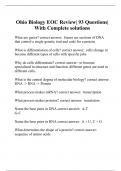
-
Ohio Biology EOC Review| 93 Questions| With Complete solutions
- Exam (elaborations) • 11 pages • 2023
- Available in package deal
-
- $12.99
- + learn more
What are genes? correct answer: Genes are sections of DNA that control a single genetic trait and code for a protein. What is differentiation of cells? correct answer: cells change to become different types of cells with specific jobs Why do cells differentiate? correct answer: to become specialized in structure and function, different genes are used in different cells. What is the central dogma of molecular biology? correct answer: DNA -> RNA -> Protein What process makes ...
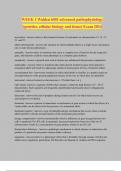
-
WEEK 1 Walden 6501 advanced pathophysiology (genetics, cellular biology and tissue) Exam 2024
- Exam (elaborations) • 2 pages • 2024
- Available in package deal
-
- $9.99
- + learn more
WEEK 1 Walden 6501 advanced pathophysiology (genetics, cellular biology and tissue) Exam 2024 acrocentric -Answer-refers to the terminal location of centromere on chromosomes 13, 14, 15, 21, and 22 allelic heterogeneity -Answer-the situation in which multiple alleles at a single locus can produce one or more disease phenotypes. amorphic -Answer-refers ro mutations that cause a complete loss of function for the respective gene, and therefore yield the same phenotype as a complete gene dele...
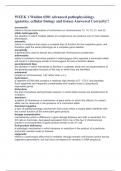
-
WEEK 1 Walden 6501 advanced pathophysiology (genetics, cellular biology and tissue) Answered Correctly!!
- Exam (elaborations) • 2 pages • 2023
-
Available in package deal
-
- $9.79
- + learn more
WEEK 1 Walden 6501 advanced pathophysiology (genetics, cellular biology and tissue) Answered Correctly!! acrocentric refers to the terminal location of centromere on chromosomes 13, 14, 15, 21, and 22 allelic heterogeneity the situation in which multiple alleles at a single locus can produce one or more disease phenotypes. amorphic refers ro mutations that cause a complete loss of function for the respective gene, and therefore yield the same phenotype as a complete gene deletion. aneup...
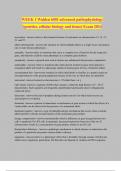
-
WEEK 1 Walden 6501 advanced pathophysiology (genetics, cellular biology and tissue) Exam 2024
- Exam (elaborations) • 2 pages • 2024
- Available in package deal
-
- $9.99
- + learn more
WEEK 1 Walden 6501 advanced pathophysiology (genetics, cellular biology and tissue) Exam 2024 acrocentric -Answer-refers to the terminal location of centromere on chromosomes 13, 14, 15, 21, and 22 allelic heterogeneity -Answer-the situation in which multiple alleles at a single locus can produce one or more disease phenotypes. amorphic -Answer-refers ro mutations that cause a complete loss of function for the respective gene, and therefore yield the same phenotype as a complete gene dele...
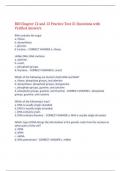
-
BIO Chapter 12 and 13 Practice Test 31 Questions with Verified Answers,100% CORRECT
- Exam (elaborations) • 7 pages • 2024
-
- $10.99
- + learn more
BIO Chapter 12 and 13 Practice Test 31 Questions with Verified Answers RNA contains the sugar a. ribose. b. deoxyribose. c. glucose. d. lactose. - CORRECT ANSWER a. ribose. Unlike DNA, RNA contains a. adenine. b. uracil. c. phosphate groups. d. thymine. - CORRECT ANSWER b. uracil. Which of the following are found in both DNA and RNA? a. ribose, phosphate groups, and adenine b. deoxyribose, phosphate groups, and guanine c. phosphate groups, guanine, and cytosine d....
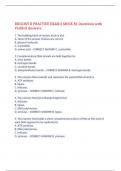
-
BIOLOGY II PRACTICE EXAM 2 MOCK 81 Questions with Verified Answers,100% CORRECT
- Exam (elaborations) • 16 pages • 2024
-
- $11.49
- + learn more
BIOLOGY II PRACTICE EXAM 2 MOCK 81 Questions with Verified Answers 1. The building block of nucleic acids is a(n) A. None of the answer choices are correct. B. glycerol molecule. C. nucleotide. D. amino acid. - CORRECT ANSWER C. nucleotide. 2. Complementary DNA strands are held together by A. ionic bonds. B. hydrogen bonds. C. covalent bonds. D. phosphodiester bonds. - CORRECT ANSWER B. hydrogen bonds. 3. The enzyme that unwinds and separates the paired DNA strands is A...
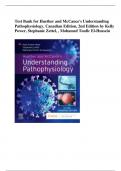
-
Test Bank for Huether and McCance's Understanding Pathophysiology, Canadian Edition, 2nd Edition by Kelly Power, Stephanie Zettel, , Mohamed Toufic El-Hussein
- Exam (elaborations) • 370 pages • 2024
-
- $46.25
- 1x sold
- + learn more
Test Bank for Huether and McCance's Understanding Pathophysiology, Canadian Edition, 2nd Edition by Kelly Power, Stephanie Zettel, , Mohamed Toufic El-Hussein Table of Contents PART ONE: BASIC CONCEPTS OF PATHOPHYSIOLOGY Unit 1: The Cell 1. Cellular Biology 2. Genes and Genetic Diseases 3. Epigenetics and Disease 4. Altered Cellular and Tissue Biology 5. Fluids and Electrolytes, Acids and Bases Unit 2: Mechanisms of Self-Defense 6. Innate Immunity: Inflammation and Wound Healing ...
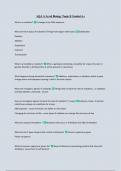
-
AQA A Level Biology Topic 8 Graded A+
- Exam (elaborations) • 13 pages • 2024
-
- $13.49
- + learn more
AQA A Level Biology Topic 8 Graded A+ What is a mutation? A change in the DNA sequence What are the 6 types of mutation? (Things that happen with bases) Deletion Addition Duplication Inversion Translocation What is a hereditary mutation? Substitution When a gameate containing a mutation for a type of cancer or genetic disorder is fertilised then it will be present in new foetus What happens during frameshift mutations? Additions, duplications or deletions wit...

How did he do that? By selling his study resources on Stuvia. Try it yourself! Discover all about earning on Stuvia


